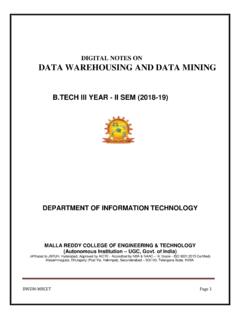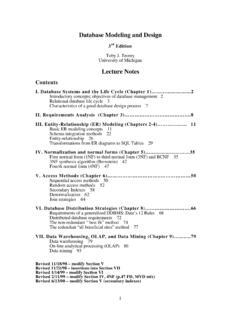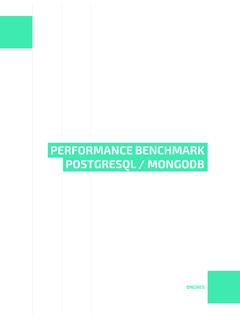Transcription of The - mtcbh.net
1 The Six Sigma HandbookA Complete Guide for Green Belts, Black Belts, and Managers at All LevelsThomas PyzdekPaul A. KellerThird Edition New York Chicago San Francisco Lisbon London Madrid Mexico City Milan New Delhi San Juan Seoul Singapore Sydney TorontoCopyright 2010, 2003, 2001 by The McGraw-Hill Companies, All rights reserved. Except as permitted under theUnited States Copyright Act of 1976, no part of this publication may be reproduced or distributed in any form or by anymeans, or stored in a database or retrieval system, without the prior written permission of the : 978-0-07-162337-7 MHID: 0-07-162337-XThe material in this eBook also appears in the print version of this title: ISBN: 978-0-07-162338-4, MHID: trademarks are trademarks of their respective owners.
2 Rather than put a trademark symbol after every occurrence of atrademarked name, we use names in an editorial fashion only, and to the benefit of the trademark owner, with no intentionof infringement of the trademark. Where such designations appear in this book, they have been printed with initial eBooks are available at special quantity discounts to use as premiums and sales promotions, or for use in cor-porate training programs. To contact a representative please e-mail us at contained in this work has been obtained by The McGraw-Hill Companies, Inc. ( McGraw-Hill ) from sourcesbelieved to be reliable. However, neither McGraw-Hill nor its authors guarantee the accuracy or completeness of any infor-mation published herein, and neither McGraw-Hill nor its authors shall be responsible for any errors, omissions, or dam-ages arising out of use of this information.
3 This work is published with the understanding that McGraw-Hill and its authorsare supplying information but are not attempting to render engineering or other professional services. If such servicesarerequired, the assistance of an appropriate professional should be OF USEThis is a copyrighted work and The McGraw-Hill Companies, Inc. ( McGraw-Hill ) and its licensors reserve all rights inand to the work. Use of this work is subject to these terms. Except as permitted under the Copyright Act of 1976 and theright to store and retrieve one copy of the work, you may not decompile, disassemble, reverse engineer, reproduce, modify,create derivative works based upon, transmit, distribute, disseminate, sell, publish or sublicense the work or any part of itwithout McGraw-Hill s prior consent.
4 You may use the work for your own noncommercial and personal use; any other useof the work is strictly prohibited. Your right to use the work may be terminated if you fail to comply with these WORK IS PROVIDED AS IS. McGRAW-HILL AND ITS LICENSORS MAKE NO GUARANTEES OR WAR-RANTIES AS TO THE ACCURACY, ADEQUACY OR COMPLETENESS OF OR RESULTS TO BE OBTAINED FROMUSING THE WORK, INCLUDING ANY INFORMATION THAT CAN BE ACCESSED THROUGH THE WORK VIAHYPERLINK OR OTHERWISE, AND EXPRESSLY DISCLAIM ANY WARRANTY, EXPRESS OR IMPLIED,INCLUDING BUT NOT LIMITED TO IMPLIED WARRANTIES OF MERCHANTABILITY OR FITNESS FOR A PAR-TICULAR PURPOSE.
5 McGraw-Hill and its licensors do not warrant or guarantee that the functions contained in the workwill meet your requirements or that its operation will be uninterrupted or error free. Neither McGraw-Hill nor its licensorsshall be liable to you or anyone else for any inaccuracy, error or omission, regardless of cause, in the work or for any dam-ages resulting therefrom. McGraw-Hill has no responsibility for the content of any information accessed through the no circumstances shall McGraw-Hill and/or its licensors be liable for any indirect, incidental, special, punitive, con-sequential or similar damages that result from the use of or inability to use the work, even if any of them has been advisedof the possibility of such damages.
6 This limitation of liability shall apply to any claim or cause whatsoever whether suchclaim or cause arises in contract, tort or .. xi Part I Six Sigma Implementation and Management 1 Building the Responsive Six Sigma Organization .. 3 What Is Six Sigma? .. 3 Why Six Sigma? .. 4 The Six Sigma Philosophy .. 5 The Change Imperative .. 11 Implementing Six Sigma .. 13 Timetable .. 14 Infrastructure .. 16 Integrating Six Sigma and Related Initiatives .. 32 Deployment to the Supply Chain .. 34 Communications and Awareness .. 36 2 Recognizing Opportunity.
7 43 Becoming a Customer and Market-Driven Enterprise .. 44 Elements of the Transformed Organization .. 46 Strategies for Communicating with Customers and Employees .. 48 Survey Development Case Study .. 52 Calculating the Value of Customer Retention .. 58 Customer Expectations, Priorities, Needs, and Voice .. 60 Quality Function Deployment .. 61 The Six Sigma Process Enterprise .. 65 The Source of Confl ict .. 67A Resolution to the Confl ict .. 67 Six Sigma and the Process Enterprise .. 70 Linking Six Sigma Projects to Strategies .. 71 The Strategy Deployment Matrix.
8 71 Deploying Differentiators to Operations .. 74 Deploying Operations Plans to Projects .. 75 Interpretation .. 76 Linking Customer Demands to Budgets .. 77 Structured Decision-Making .. 77iii 3 Data-Driven Management .. 87 Attributes of Good Metrics .. 87 The Balanced Scorecard .. 89 Measuring Causes and Effects .. 90 Customer Perspective .. 92 Internal Process Perspective .. 94 Innovation and Learning Perspective .. 95 Financial Perspective .. 95 Cost of Poor Quality .. 97 Cost of Quality Examples .. 99 Strategy Deployment Plan.
9 102 Dashboard Design .. 105 Information Systems Requirements .. 107 Integrating Six Sigma with Other Information Systems Technologies .. 108 Data Warehousing .. 108 OLAP .. 110 Data Mining .. 110 OLAP, Data Mining, and Six Sigma .. 112 Benchmarking .. 112 The Benchmarking Process .. 112 Getting Started with Benchmarking .. 113 Why Benchmarking Efforts Fail .. 114 The Benefi ts of Benchmarking .. 116 Some Dangers of Benchmarking .. 116 4 Maximizing Resources .. 117 Choosing the Right Projects .. 117 Types of Projects.
10 117 Analyzing Project Candidates .. 118 Using Pareto Analysis to Identify Six Sigma Project Candidates .. 125 Throughput-Based Project Selection .. 127 Ongoing Management Support .. 133 Internal Roadblocks .. 133 External Roadblocks .. 134 Individual Barriers to Change .. 134 Ineffective Management Support Strategies .. 135 Effective Management Support Strategies .. 136 Cross-Functional Collaboration .. 136 Tracking Six Sigma Project Results .. 137 Financial Results Validation .. 138 Team Performance Evaluation.




